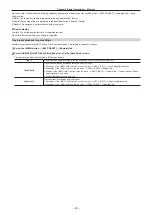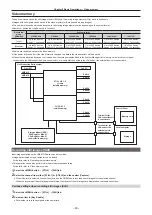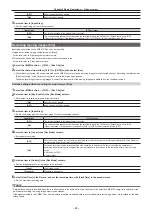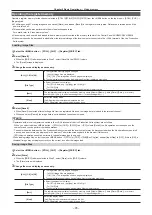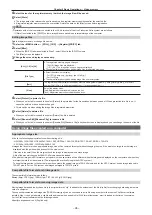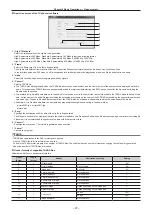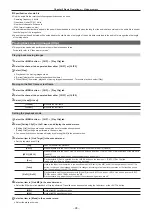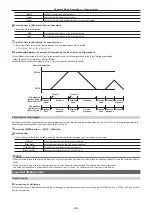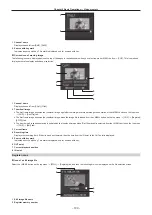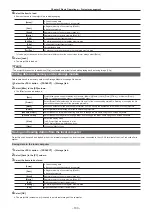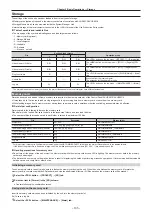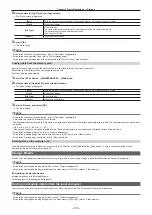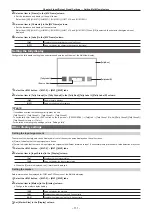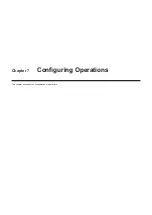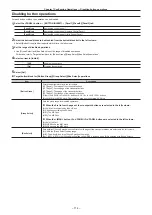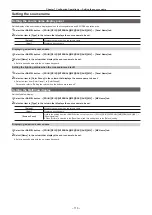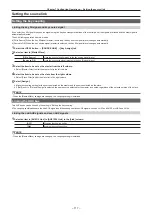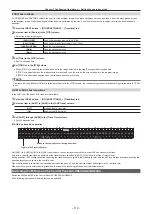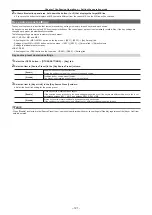
– 106 –
Chapter 5 Basic Operations — Storage
2
Select an item in [Log File] in the [Log] column.
f
The [Save] screen is displayed.
[Sort]
Sorts the file icon view in ascending or descending order by file number, file name, or date.
[View]
Fixed to icon display.
[File Type]
Fixed to file type.
The name of the folder where a log file is saved becomes the file name of the log file.
File names are assigned automatically as follows.
hs001.log to hs100.log
[Cancel]
Closes the [Save] screen.
3
Select [OK].
f
The file is saved.
@
@
NOTE
t
For details on the data save destination, refer to “Data folder configuration”.
t
For details on saving project files, refer to “Project management”.
t
For details on saving image files in the video memory (Still, Clip), refer to “Video memory”.
Loading data from the memory card
Insert the memory card on which the data is saved in a specified folder into the memory card slot.
Data stored in other folders will not be recognized by the unit.
Ex) When loading the update file
1
Select the <SYS> button
→
[MAINTENANCE]
→
[Status] tab.
2
Select an item in [Update File] in the [Update] column.
f
The [Load] screen is displayed.
[Sort]
Sorts the file icon view in ascending or descending order by file number, file name, or date.
[View]
Fixed to icon display.
[File Type]
Fixed to file type.
[Cancel]
Closes the [Load] screen.
3
Select a file icon, and select [OK].
f
The file is loaded.
@
@
NOTE
t
For details on the data save destination, refer to “Data folder configuration”.
t
A file name can contain a maximum 32 characters.
t
The characters that can be used in a file name are single-byte alphanumeric characters and single-byte symbols. The characters that can be used are
as follows.
A to Z, a to z, 0 to 9, ! # $ % & ' ( ) - . @ ^ _ ` { }
t
If the name of the file to be loaded consists of more than eight characters, the unit displays a shortened version of the file name.
t
For details on loading project files, refer to “Project management”.
t
For details on loading image files from the video memory (Still, Clip), refer to “Video memory”.
t
For details on loading plug-in software, refer to “Plug-in software”.
Deleting files on the memory card
To delete unnecessary project files and video memory (Still, Clip) files, select [Delete] on the [Misc] screen. To delete unnecessary files of other
functions, delete using the computer. (page 96)
Storage Module
You can save and load project files and video memory image files to and from the storage module installed inside the System Manager Unit.
@
@
NOTE
t
For details on saving and loading project files, refer to “Project management”.
t
r
Initializing the storage module
Initialize data saved in the Storage Module.
For details, refer to “Initializing the setting data”.
Saving and loading data in/from the local computer
Only the menu of the local computer connected to the <LAN> terminal of the Live Production Suite system is displayed.
@
@
NOTE
t
For details on saving and loading project files, refer to “Project management”.
t
Summary of Contents for Live Production Suite Series
Page 5: ...Please read this chapter and check the accessories before use Chapter 1 Overview ...
Page 11: ...This chapter describes installation and connection Chapter 2 Installation and Connection ...
Page 50: ...This chapter describes menu operations Chapter 5 Basic Operations ...
Page 113: ...This chapter describes the configuration of operations Chapter 7 Configuring Operations ...
Page 122: ...This chapter describes how to operate system menus Chapter 8 System Menu ...
Page 136: ...This chapter describes plug in functions Chapter 9 External Interfaces ...
Page 140: ... 140 Chapter 10 Specifications Dimensions Dimensions of the XPT Unit AV LSX10 Unit mm inch ...
Page 141: ... 141 Chapter 10 Specifications Dimensions Dimensions of the ME Unit AV LSM10 Unit mm inch ...
Page 153: ...This chapter describes the setting menu table and terms Chapter 11 Appendix ...
Page 176: ...Web Site https www panasonic com Panasonic Corporation 2020 ...

